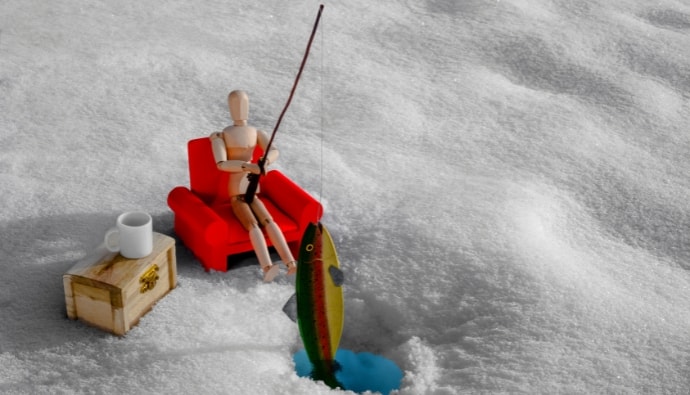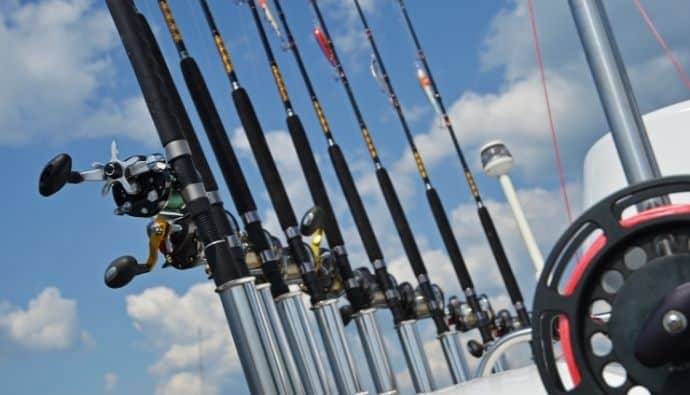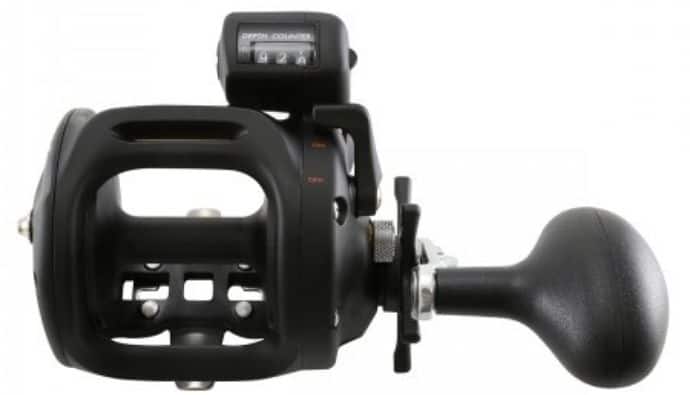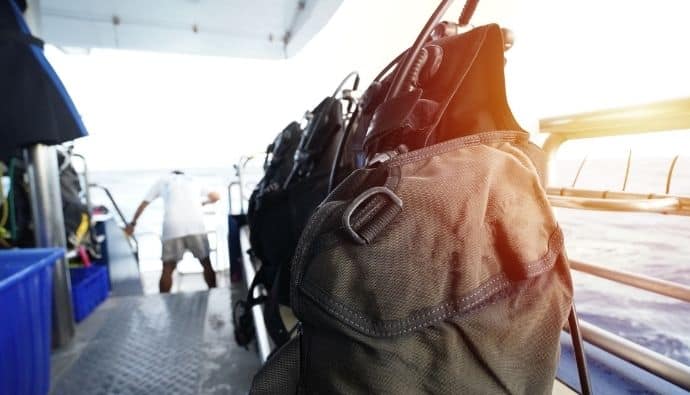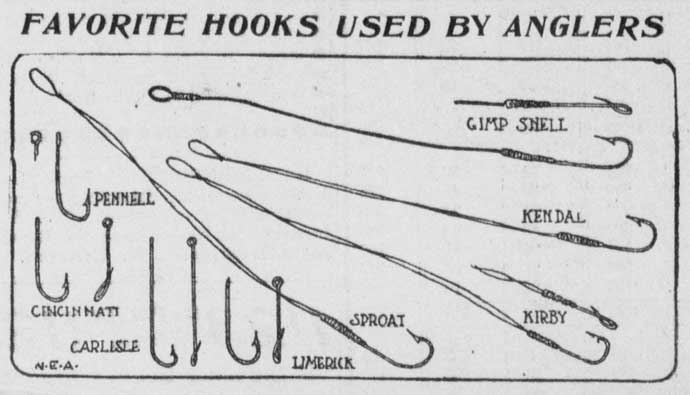Ice fishing flashers are invaluable because they allow you to ‘see’ beneath the ice by revealing objects in the water column. This simple sonar can help you make the most of your ice fishing trips, even if you are freezing out there.
These do an incredible job of analyzing what is beneath the ice so you can land more significant and better catches. This piece of ice fishing equipment is a must-have if you are going on an ice fishing trip, but which model should you choose? Here are our best picks, along with their pros and cons, so you can make an informed decision.
- Marcum LX-9
- MarCum LX-7 Ice Fishing Sonar System/Fishfinder
- MarCum Flasher System M5
- Vexilar FLX-28 Ice ProPack II
- Vexilar FL-12 Ice ProPack II
- Humminbird ICE-55 Six Color Flasher with LCD
- Vexilar FL-18 Ice-Ducer Combo
- Humminbird ICE-35 Three Color Flasher
- Best Garmin Ice Fishing Flasher-Garmin Striker Plus 5cv with transducer
- Deeper PRO+ Smart Sonar
10 Best Ice Fishing Flashers
1. Marcum LX-9
This ice flasher boasts an 8” Flat Panel with color LED and Video out that gives crisp results even if you are fishing in murky water. The on-screen dashboard displays the battery voltage you have left, digital depth, target adjustment, range, and gain.
The LX-9 also boasts a switchable dual-beam transducer, along with a color camera that is equipped with Sony’s Super HAD II CCD optics for bright displays. Plus, it is attached to 75” of sturdy cable. However, the LX-9 doesn’t perform well past 30 feet, and the camera quality could be better as well.
On the other hand, it stands up to icy conditions pretty well, and the large LCD screen makes for an excellent flasher display and proves invaluable when visibility is limited or in adverse weather conditions.
2. MarCum LX-7 Ice Fishing Sonar System/Fishfinder
The MarCum LX-7 is an ice fishing flasher that is easy to use for novices. It boasts a large screen that offers an impressive 800 x 600 in terms of resolution and multiple windows for optimal underwater viewing. This includes a circular flasher, a vertical zoom, and a full graph.
Additionally, this ice fishing flasher comes with software that can be updated to enhance its performance. We did have trouble reading the screen under direct sunlight, though, which can be a problem if the sky is clear of clouds.
Plus, this flasher does not come with Ethernet connectivity. On the other hand, this unit is exceptionally good at detecting tiny fish, and the high def color LCD display helps anglers distinguish between targets irrespective of their size.
3. MarCum Flasher System M5
The MarCum Flasher System M5 is also considered the best ice fish finder. It works in complete silence, so it doesn’t startle the fish, and it comes with a high color definition. This feature, combined with the acute .75-inch target separation, determines each fish on the screen, so you know exactly when a fish is about to touch your jig.
This ice-fishing flasher can be challenging to read in heavy snow, so you may get a bit frustrated if you find yourself fishing during a gale.
However, what makes this flasher a good buy is its precision-tuned dual-beam transducer, which can allow you to switch between 8 and 20-degree cones.
4. Vexilar FLX-28 Ice ProPack II
The features of the Vexilar FLX-28 read like the ideal ice fishing electronics wish list. This easy-to-use ice fishing flasher comes with two zoom zones, and five color options for max visibility, and displays battery status as well.
This includes a day and night brightness setting so you can read the screen without squinting, irrespective of the light conditions. It also comes with a unique weed mode that distinguishes between fish and cover, and there is also a low-power option for shallow water that muffles the sound of the transducer.
However, you cannot use the low shallow mode if the flasher is at full charge. It can only be effective when it is almost out of charge.
But that is a small issue compared to how compact and lightweight the unit is. The long battery life can also last for hours, giving you plenty of time to get an elusive fish making it perfect if you’re into ice fishing at night.
5. Vexilar FL-12 Ice ProPack II
The easy-to-use Vexilar FL-12 Ice ProPack II is ideal for flasher fishing in icy weather conditions. The unit boasts a flat screen that offers a wide viewing angle and over 20 interference rejection settings that prevent nearby sonars from interfering and distorting results.
While it is ideal for ice fishing, an ice flasher can also help you detect fish in open water as well. These features are what make this the best ice-fishing fish finder you can get if you fish year-round.
This is far from a cheap ice fishing flasher, though, which is a bit strange because it does not come with zoom or bottom lock capabilities. However, what we liked about the Vexilar FL-12 was its ability to identify targets as tiny as 1 inch!
6. Humminbird ICE-55 Six Color Flasher with LCD
If you are looking for an ice flasher that has unique and easy-to-operate features, the Humminbird ICE-55 will not disappoint. This ice flasher gives anglers a more in-depth look at what’s beneath the ice with a wide range of viewing options.
This includes 2D sonar combo views on the same screen and the ability to see lure and fish history. These features work together to help you determine what’s turning fish on and off so you can adjust your performance accordingly. The dual-frequency sonar offers beam options that can help you fine-tune coverage.
The poor quality of the carrying case was an issue, though. Plus, the transducer cord does not fit as firmly into the back of the unit as we would have liked.
On the other hand, those were quickly forgotten, especially when we discovered that it boasts six color displays that the visually impaired will really appreciate. All in all, the ICE 55 definitely has a place in ice fishing flasher reviews.
7. Vexilar FL-18 Ice-Ducer Combo
The Vexilar FL-18 ice fishing flasher boasts performance and features that novice and veteran anglers will appreciate. This three-color flasher allows users to zoom in on the bottom all the way down to 6 feet without losing sight of the water column in real time.
This is a pretty useful feature for anglers who prefer to fish for bottom-dwelling panfish, walleye, and bass, and with a target of less than half an inch, spotting them will not be a problem. Additionally, this ice fishing flasher also boasts built-in interference rejection.
The Vexilar FL-18 looks fantastic and has excellent features, but we found that it loses some accuracy if it is used on a boat. But it performs impeccably well on the ice.
What really sets it apart is the 3-color LED readout that tells you if the targets are weak, medium, or strong using different colors.
8. Humminbird ICE-35 Three-Color Flasher
The Humminbird ICE-35 three-color flasher also makes it on the list as an ice fishing flasher that ice anglers can appreciate in cold weather conditions. This unit offers incredibly detailed readings because it operates at 450/240 kHz and features 19/9 degree beams.
Its high-frequency sonar can detect targets in depths of up to 200 ft under the water, and the full range zoom allows users to focus on any part of the water column for detailed readings. Additionally, the controls allow users to adjust the fishfinder to spot fish at different depths.
One downside of the ICE 35 is that its transducer cannot read the temperature of the water. Plus, it cannot show accurate readings past 200 ft.
What is really great about the unit is that you can test it and get an idea of the performance via the demo mode. That is much better than wasting time practicing on the ice! There aren’t many ice flashers that offer this feature, either.
9. Garmin Striker Plus 5cv with transducer
Best Garmin Ice Fishing Flasher
Many ice-fishing anglers swear by this ice flasher in terms of performance. The Garmin Striker Plus 5cv comes with a GPS finder that maintains your position irrespective of your place in the water.
Plus, the GPS also allows users to mark waypoints for different locations so you can return to the same spot later without getting lost. Plus, the unit is made to be readable in any type of weather you find yourself in, along with a large screen that will give you a crystal clear view of the depths.
However, as far as performance goes, this unit can give you a bit of trouble in sub-zero temperatures and fishing conditions.
On the other hand, by pairing it with the Garmin CHIRP traditional sonar, you can detect and catch more fish than you think you can. Check it out for yourself and see why it is the best flasher on the marker as well. Can’t go wrong with a Garmin Striker, that’s for sure.
10. Deeper PRO+ Smart Sonar
You won’t need any help with this unit. Coming in at number 10, the Depper PRO+ Smart Sonar is a unit that will also wow you with its unique features. As the sleekest-looking unit on the market, the Deer Pro+ boasts high-end sonar footprint technology that will give you instant depth and water temperature readings.
This includes weed location and how thick the cover is, which it detects using an in-built GPS system. You can even pinpoint exactly where the fish are when you are retrieving the sonar.
However, the Deeper Pro+ has to be half in and half out of the water for the sonar to work correctly, which can be frustrating. Plus, it is heavy enough to require a thick rod, especially if you want to cast it in deep water. Of course, the heavier the rod, the more power you will need to throw far.
Besides these issues, the sonar is pretty easy to use and ideal not just for ice fishing but also for anglers who fish from the bank. Plus, all of the scans you take will be saved for later retrieval and analysis. We found this sonar quite useful when we were fishing over silt-filled water.
What is an Ice Fishing Flasher?
Before you get the best flasher on the market, you need to understand precisely what it can offer you. Simply put, they are sonar unit that allows anglers to detect objects in a water column through a screen. It will enable users to determine the digital depth or depth ranges of the water and the exact spots where they can find fish.
How Does an Ice Fishing Flasher Work/How to Read a Fish Flasher?
What makes this technology special is that it can show you depth as well as your lure and the fish you are trying to catch. The first thing to do is drop the transducer in the hole, and the flasher displays the bottom as a large red area.
Green bars at the bottom are weeds and vegetation, and if you see yellow lines in them, it may be the mark of fish trying to hide. Your descending lure will appear as a yellow or green bar down the water column. Depending on the model and depth ranges of the unit, it can read from one foot to 240 feet of water.

The sonar of the flasher is called a cone, and it starts from the transducer and expands down at the bottom. As the water depth increases, the size of the cone gets more abundant, and fish that are outside its circumference will give weaker returns to the unit.
Similarly, fish that are directly below the transducer will come up as dark red lines on the screen. Flasher ice fishing is not difficult if you know how to read one. For example, the key to differentiating between a red bottom and a red-colored fish is movement.
If it’s a fish, it will move away from the bottom eventually. So when you see the latter, drop your bait quickly and keep an eye on the flasher as it falls. As the fish swims closer to the bait, the red line will get thicker till it gets close enough to the jig that it ‘merges’ with it.
This usually indicates a bite, but don’t be fooled. Some fish prefer to chase the bait as it is reeled in, so draw up quickly if you feel the tip of your rod jerk. You may need some help perfecting the technique, but the key to using a flasher well is practice.
Ice Fishing Fish Finder vs. Flasher?
Both a flasher and the best fish finder, ice fishing shows depth, whether there are any fish in the spot you cast in, and how the fish respond to the lure. The display is the most significant difference in features between the two.
For example, the flasher has a simple dial with colorful lights that show what the sonar detects. The water column is displayed as a circle rather than vertically, which some anglers may find confusing at first.
Fishfinders, on the other hand, have graphs that are easier to understand, especially on open water. Most units also come with an RTS window that displays performance history, which can come in handy if you get distracted easily. When it comes to power and GPS quality, the fish finder usually comes out on top.
This is what makes it preferable for most ice fishing anglers, but you should check out flashers with useful features before finalizing your decision.
How to Pick the Best Ice Fishing Flasher
There are many ice fishing flashers on the market, but don’t choose randomly, or you will waste your money. Here are some features you should look into before finalizing a decision:
Durability
The unit should be compact and solid enough to withstand bumps and dings as it lands on the bottom of the water column. Plus, it should not crack if it is dropped on land accidentally, and it should provide accurate readings even in sub-zero temperatures.
Portability
You don’t want to take equipment with you that will weigh you down as you walk across the ice looking for a fishing spot. Similarly, an ideal flasher should be sturdy but not too heavy so you have to think twice before taking it. The best ones come with compact carrying cases that also keep them protected from the elements.
Lighting and Resolution
The flasher should be simple to read, irrespective of the lighting and weather conditions you encounter. Look for a unit that can be read clearly when it is overcast. It should also have a high res screen/split-screen, so you know exactly what you are looking at.
Cone Size
The cone size is what tells you how far-reaching the sonar beam is and how deep the water is. It also determines the amount of detail the unit can detect. So a narrow cone size will emit a narrow beam that can detect fish deep underwater.
However, a large cone will capture a wider area but at the expense of details. In other words, the type of fish you are angling for should determine the unit with the cone size you need.
Battery Life
The battery power of a flasher depends on the hours you plan on fishing out on the ice since cold weather drains batteries. In other words, look for a unit that can last for as many hours as you want to fish.
Transducer and Frequency
This is one of the essential features of a flasher. The transducer scans the water below the ice and bounces the signal back to you via sonar waves, which are interpreted and displayed on the flasher screen.
Naturally, it has to be durable enough to withstand sub-zero temperatures long enough to get accurate readings. Plus, the device should also offer high-frequency levels for better detail and target resolution.
Frequently Asked Questions
Q: What is the best fish flasher on the market?
A: The best flasher for ice fishing on the market is one that has all of the features you need to catch as many fish as you need without stressing yourself out. The units above are not the only ones you should look into if you want to make an informed decision.
Q: What is the best fish finder for ice fishing?
A: The best fishfinder should have features that can maximize your performance on the ice.
Q: Can you use a regular fish finder for ice fishing?
A: Yes, you can. Most modern fish finders can be converted to work for ice fishing, but you will need to take a portable power supply with you and figure out how you can maneuver the transcender into the ice hole. Some brands sell boat-to-ice conversion kits you should definitely look into if you don’t want to deal with the hassle.
Q: What is the difference between chirp and sonar?
A: A CHIRPing device transmits a sweeping set of frequencies, while a typical sonar only transmits a single frequency. Plus, a sonar only transmits 1% at a time, but a CHIRP transmits ascending pulses that are ten times as long in terms of duration.
Q: What does the GPS integration in a fish finder do?
A: GPS integration helps anglers get an overview of the area they are fishing in and mark spots that they can come back to later. Most modern fish finders have this feature already, along with marine radar and compasses. These come in pretty handy if you encounter low visibility below and above water.
Q: Should I get a portable or a fixed fishfinder?
A: Both of these options have their benefits, so your choice will depend on the type of boat you own and the fishing you need to do. For example, a portable unit is versatile so that you can take it on a canoe out in deeper water. Affixed options are usually more high-tech in comparison and thus give better readings. So if you fish occasionally, you should go for the portable option, but if you are a serious or competitive angler, choose the high-tech fishfinder to improve your game.
Q: What should I look for in screen size in a fish finder?
A: Look for a unit that has the biggest screen you can find. These can be anywhere between 3.5” to 16”. The larger the screen, the more details you will be able to see. If you are on a budget, choose a decent 9” screen, and you should be good.
Insider Advice
Flashers that can offer higher frequencies can provide you with crispier detail and target resolution. However, you should go for dual transducers to be on the safe side. These provide both low and high frequencies and can thus give you the exact coverage you need. This will come in pretty handy when you are trying to determine depth ranges as a novice.




 Facebook
Facebook YouTube
YouTube




